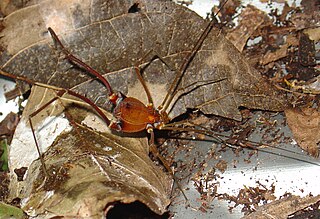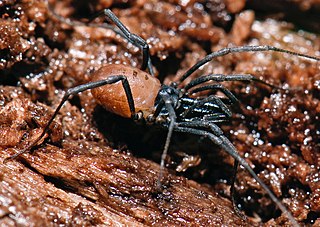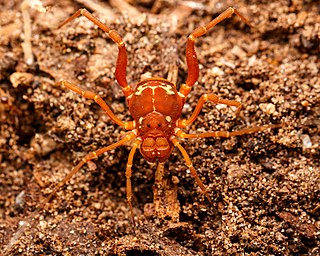Related Research Articles

The Opiliones are an order of arachnids colloquially known as harvestmen, harvesters, harvest spiders, or daddy longlegs. As of April 2017, over 6,650 species of harvestmen have been discovered worldwide, although the total number of extant species may exceed 10,000. The order Opiliones includes five suborders: Cyphophthalmi, Eupnoi, Dyspnoi, Laniatores, and Tetrophthalmi, which were named in 2014.

Gonyleptidae is a neotropical family of harvestmen with more than 800 species, the largest in the Suborder Laniatores and the second largest of the Opiliones as a whole. The largest known harvestmen are gonyleptids.

Cosmetidae is a family of harvestmen in the suborder Laniatores. With over 700 species, it is one of the largest families in Opiliones. They are distributed from Argentina to the southern USA with the highest diversity in northern South America, Central America and Mexico. This Nearctic-Neotropical family comprises Opiliones with elaborate white/yellow/green/orange/red stripes and spots on the dorsal scutum and peculiar pedipalps strongly compressed and applied on the chelicerae.

Dyspnoi is a suborder of harvestmen, currently comprising 43 extant genera and 356 extant species, although more species are expected to be described in the future. The eight families are currently grouped into three superfamilies: the Acropsopilionoidea, Ischyropsalidioidea, and Troguloidea.

Troglosironidae is a family of harvestmen with seventeen described species in a single genus, Troglosiro, which is found on the island of New Caledonia, in the Pacific Ocean.

The Neogoveidae are a family of harvestmen with 27 described species in eight genera. However, eight species of Huitaca, 17 species of Metagovea and 12 species of Neogovea are currently awaiting description.

Nipponopsalididae is a family of harvestmen with three described species in one genus, Nipponopsalis, which is found in East Asia.

Ischyropsalididae is a family of harvestmen with 31 described species in 3 genera, found in Europe and North America.

The Cranaidae are a family of neotropical harvestmen within the suborder Laniatores.

The Cladonychiidae are a small family of harvestman with about 33 described species, within the suborder Laniatores.

Taracus is a genus of harvestman, or Opiliones, typically found living in limestone and lava caves in the United States. They grow to a size of 2.0–5.5 mm (0.08–0.22 in).

Taracidae is a family of harvestmen in the order Opiliones. There are 4 genera and 23 described species in Taracidae.
Cladolasma, is a genus of harvestmen belonging to the family Nemastomatidae. The genus contains 4 species. They are confined to China, Japan and Thailand.

Vonones is a genus of armoured harvestmen in the family Cosmetidae. There are at least two described species in Vonones.
Enigmina is a genus of armoured harvestmen in the family Phalangodidae. There are at least two described species in Enigmina.

Ortholasmatinae is a subfamily of harvestmen with 27 described species in 7 genera.
Giljarovia is a genus of harvestmen in the family Nemastomatidae with 11 described species from the Caucasus region.

Cosmetinae is a subfamily of harvestmen in the family Cosmetidae.

Pantopsalis listeri is a species of harvestman in the family Neopilionidae.
References
- ↑ Hallan J. (2005) Manaosbiidae in Synopsis Of The Described Opiliones Of The World